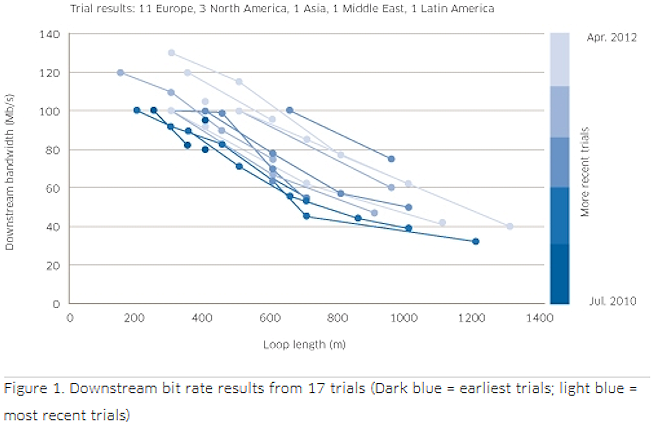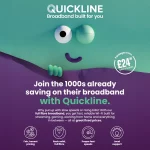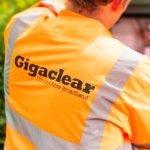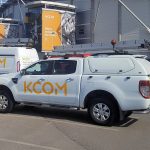Alcatel-Lucent ISP Trials Deliver 130Mbps via VDSL2 Broadband Vectoring
Global telecoms firm Alcatel-Lucent last year released the results from its recent ISP trials of VDSL2 Vectoring technology, which revealed that the solution has the potential to push BT’s UK superfast FTTC download speeds up to 130Mbps (Megabits) at around 300m to 600m (metres) from a local street cabinet (possibly hitting 200Mbps with line bonding).
Alcatel-Lucent became the first telecoms technology company to launch a commercial vectoring solution in 2011, which is designed to reduce crosstalk (interference) on copper based VDSL2 telephone cables and can thus open the door to faster broadband speeds over greater distances (i.e. this works in a similar way to the noise cancellation technology used in some headphones).
Advertisement
BT are already understood to be examining the solution as a potential upgrade for their existing Fibre-to-the-Cabinet (FTTC) service, which currently delivers download speeds of up to 80Mbps (20Mbps uploads) by running a fibre optic cable to your local street cabinet (profile 17a). However the “last mile” connection into homes is done by using VDSL2 technology over your existing copper telephone line (similar to ADSL2+ broadband but faster over the shorter distances).
The new trial data appears to support earlier performance estimates for Alcatel-Lucent’s Vectoring solution, which has now been tested with a total of 17 ISPs from around the world (11 of which were European providers). This is useful because the EU expects 50% of European homes to have access to a 100Mbps connection by 2020 and Vectoring could conceivably help some countries to deliver that.

Alcatel-Lucent’s Trial Report
Seventeen very high speed digital subscriber line 2 (VDSL2) vectoring trials, conducted by Alcatel-Lucent with various [ISPs] around the world, have demonstrated that 100Mbps is achievable over copper at 400 m — and even up to 500 m. These trials focused mostly on 300 m to 600 m loop lengths, reflecting the typical fiber to the node (FTTN) topologies that CSPs are considering for vectoring.
Because trial results improved significantly in a short time with technology and product evolution, Figure 1 uses color coding to indicate when specific downstream bit rates were recorded. Some of the early trials, beginning in July 2010, were capped at 100Mbps due to technology and prototype limitations. But the most recent trials in April 2012 achieved bit rates between 100 Mbps and 130 Mbps.
These improvements are partly explained by the switch from prototypes to commercial hardware and software. In addition, G.inp coding now provides a retransmission-based error-handling mechanism for VDSL2 vectoring which results in significantly lower overhead. By replacing the Forward Error Correction (FEC) mechanism, G.inp avoids the FEC-associated fixed overhead of about 12 percent, and G.inp only kicks in when there’s actually an error to correct.
Cable diameter does have an impact on the results and accounts for most of the variation (between trials performed in the same timeframe) in Figure 1. In general, CSPs can expect to see very good vectoring gains whatever cable type they use. The good news is vectoring delivers greater gain on poorer cable that is heavily impacted by crosstalk, because the crosstalk can be canceled by vectoring.
The Vectoring solution was also able to boost upload speeds from the current 20Mbps figure and up to a typical speed of 40Mbps at loop lengths from 200m to 500m (achieved while download speeds sat at around 100Mbps). This was possible because vectoring allows ISPs to “relax their upstream power back off settings” (UPBO), which boosts upstream bit rates.
Customers with deep pockets and two copper pairs available to their home will also be able to use vectoring and line bonding together (e.g. linking 2 phone lines for faster speeds), which in the trials delivered a download speed of 200Mbps (50Mbps uploads) at 400m (with normal UPBO settings – relaxing this could boost upstream performance even further). At 800m, with vectoring disabled (i.e. only line-bonding was used), this fell to just 75Mbps downstream and 17Mbps upstream.
Advertisement
So what can we expect in the future? BT does plan to boost its FTTC (VDSL2) service speeds up to around 100Mbps or more in the not too distant future, although initially this is likely to come from a more cost effective increase to the relevant spectrum allocation (currently set at 17MHz). By contrast vectoring would carry a more noticeable upgrade cost and BT is currently more focused on expanding its raw FTTC’s coverage.
Meanwhile the ITU-T’s new VDSL2 G.vector (G.993.5) specification has only just completed its first interoperability testing and other firms are already developing their own solutions for boosting DSL speeds (e.g. DSL Rings). In other words it’s still too early to say precisely what solution BT will go for but FTTC performance is clearly destined to increase.
Last March 2012 BT told ISPreview.co.uk, “We believe other technologies such as vectoring could see some FTTC lines deliver 100Mbps or above, though these new technologies will not be applicable on all lines” (here).
NOTE: I actually drafted this article a couple of months back but a date bug meant it was never posted and we all failed to notice because of a busy news week. I’ve updated it and re-posted today.
Advertisement
Mark is a professional technology writer, IT consultant and computer engineer from Dorset (England), he also founded ISPreview in 1999 and enjoys analysing the latest telecoms and broadband developments. Find me on X (Twitter), Mastodon, Facebook, BlueSky, Threads.net and Linkedin.
« Top 8 UK Fastest Broadband ISPs by Speed for 2012 and 2011 Compared

















































Comments are closed